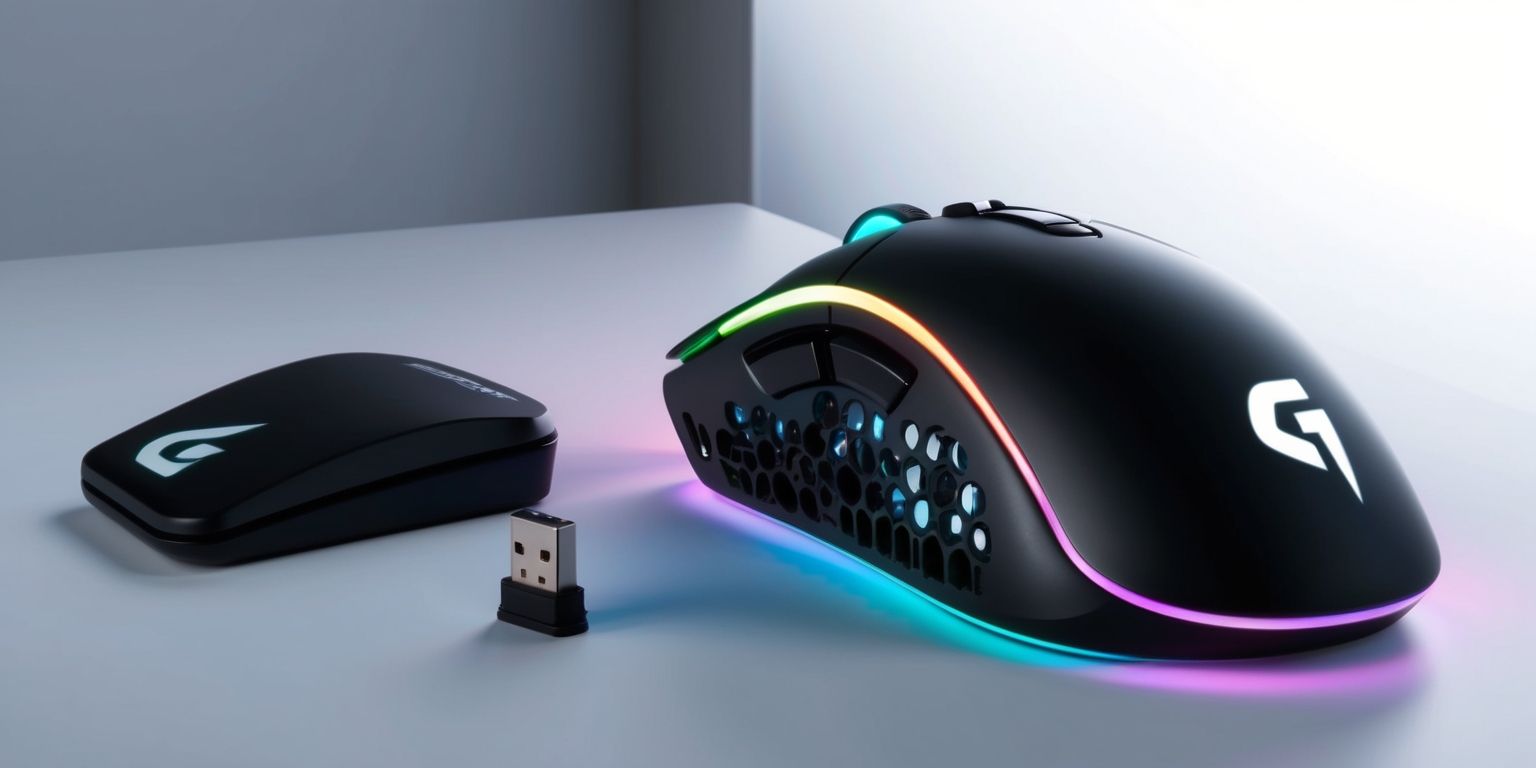Beyond Convention: A Revolutionary Dive into the Glorious Model O 3 Wireless Experience
- Nov 11, 2025
- 0

The Glorious Model O 3 Wireless presents a distinct approach to gaming peripherals by blending innovative features with a design that dares to stand apart from the everyday crowd. In a market where many devices seem to blend into one another, this device offers a reimagined outlook on visual appeal, functionality, and comfort. The integration of customizable lighting, adaptable batteries, and a robust yet unconventional shape creates a conversation piece for enthusiasts who appreciate the melding of aesthetics with practicality. Its design choices and performance characteristics beckon a closer look to understand both the ingenuity behind the engineering and the compromises that have been made in the pursuit of a modern, dynamic gaming tool.
Artful Construction and Visual Impact
The first striking element of the Model O 3 Wireless is its deliberately segmented design that diverts from the typical seamless contours seen in top-tier competitors. The device boasts distinct panels that separate the main body from the click modules, giving it a sculpted appearance enhanced by a prominent RGB strip running across the center. This design evokes an almost futuristic vibe while also offering visual differentiation in an industry saturated with homogenous models. The intricate balance between brightness and darkness over the floating hump and side panels It produces an impact that is both powerfully theatrical and… functional. Each illuminated section does more than just catch the eye, as it subtly guides the user towards a more engaged and interactive experience during gameplay.
Ergonomics, Weight, and Handling Sensibilities
Comfort and precision in prolonged gameplay sessions are critical, and the Model O 3 Wireless addresses this through its thoughtful dimensions and heft. While the device is notably heavier than some of its ultralight predecessors, its broader base and moderate height contribute to an ergonomically balanced feel, accommodating extensive use without excessive strain. The weight is cleverly counterbalanced so that even with the additional components, such as the integrated battery system, the mouse feels stable and responsive. The design provides ample surface area for varied grip styles, ensuring that users with different hand sizes can utilize it comfortably. Although the additional weight may require a period of adjustment, it ultimately supports a smoother motion and steadier control over rapid, competitive movements.
Innovative Battery Modularity and Power Solutions
Among the most forward-thinking characteristics of this… device is its dynamic battery arrangement. The Model O 3 Wireless introduces hot-swappable batteries that allow users to change power cells on the fly without the need to interrupt gameplay entirely. Featuring dual external pods alongside an in-built backup battery, this design caters to uninterrupted sessions and flexible power management. The external modules not only serve as additional energy reservoirs but also double as functional elements in the device’s physical design. Indicators on the charging station alert users with real-time power levels, ensuring that the device is always ready for intensive sessions. Although this modular approach introduces a layer of versatility, it also raises questions about the overall premium cost required to integrate such technology.
Button Arrangement and Control Customization

The Model O 3 Wireless takes a measured approach to input customization by retaining a traditional two-button side layout while enhancing its overall functionality with a dedicated DPI shifter located under the scroll wheel. This deliberate placement of controls allows gamers to quickly adjust sensitivity on the fly during high-stakes moments. Additionally, a larger housing for a 2.4GHz receiver not only facilitates connectivity but also includes a configurable multi-function button. This extra control option opens up opportunities for personalizing gameplay, whether it be for in-game commands or complex macros. While the tactile feedback of the side clickers in this model is designed for swift action, the relatively low resistance in these buttons might require acclimation, particularly for those with a more forceful grip. The nuanced design strikes a balance between fluid responsiveness and intuitive input management.
Software Integration and Feature Customization
Embedded within the Model O 3 Wireless is a software ecosystem that allows users to fine-tune settings such as polling rates, DPI presets, and lighting effects. The dedicated configuration software provides access to detailed sensor features, including lift-off distances and motion syncing options, catering to users who demand precision and customization in their hardware. However, the software interface is noted for being somewhat rugged when compared to the smoother experiences offered by leading brands, occasionally placing a heavier load on system resources. Despite this, it offers an impressive range of customizations that can transform the device into a tool highly tailored to individual gameplay styles. The absence of macro recording capabilities, however, marks a notable omission for power users who rely on complex command sequences during competitive matches.
Wireless Connectivity and Communication Protocols
The Model O 3 Wireless employs dual connectivity methods by offering both a 2.4GHz connection and Bluetooth capabilities. This dual-modality ensures a versatile range of usage scenarios, from high-speed competitive play to more relaxed, everyday tasks. The mouse achieves an impressive wireless polling rate of up to 8,000Hz under the 2.4GHz protocol, allowing it to match the responsiveness demanded by high-intensity gaming sessions. The external dongle, aside from serving as a wireless receiver, also doubles as a charger for spare battery modules. While the option to use a smaller, standalone receiver is available, the reliance on external hardware infuses another dimension of intricacy that might be viewed as both a convenience and a potential point of failure. This flexible connectivity setup demonstrates a deliberate compromise between cutting-edge performance and integrated design simplicity.
Sensor Precision and Movement Tracking
The device is equipped with Glorious’s proprietary BAMF sensor, which is designed to deliver high-speed tracking with a DPI ceiling of up to 30,000 and a rapid tracking speed measured in inches per second. The sophisticated sensor system promises a level of accuracy that places it in line with other competitive models in its price range. While the theoretical maximums may exceed what many players actually utilize, they provide a buffer for those who engage in high-speed gameplay. The sensor’s performance supports swift directional changes and meticulous cursor management, ensuring that even in fast-paced environments the mouse maintains pinpoint accuracy. This level of tracking precision is essential for gamers who demand that every movement translates seamlessly into in-game performance, allowing the device to serve as a reliable extension of their intent.
Advanced Switch Technologies and Tactile Feedback
Central to the interactive experience of the Model O 3 Wireless are its optical switches, which have been engineered for rapid responsiveness and pronounced tactile feedback. These switches offer a noticeably firm landing sensation when engaged, producing a distinct auditory cue that is reminiscent of mechanical key actions. While this feedback is beneficial for fast-paced reaction requirements, it does introduce a sharper feel compared to the smoother transitions offered by more conventional, softer alternatives. The auditory signals from the switches serve as both confirmation and a subtle reminder of the underlying precision engineering. This nuanced behavior of the switches underscores the emphasis on performance over a purely silent operation, making it an appealing choice for users who value tactile clarity during intense gaming sessions.
Comparative Analysis in a Crowded Market
In the broader ecosystem of gaming peripherals, the Model O 3 Wireless finds itself positioned in a highly competitive arena where price and functionality are in constant balance. Its $159.99 tag places it alongside several well-regarded models from established brands that are known for their refined aesthetics and polished performance. When compared to devices from other prominent manufacturers, the Model O 3 Wireless offers a unique proposition with its hot-swappable batteries and distinctive segmented design, yet it faces challenges in matching the premium finish and software integration of its competitors. For users focused squarely on cutting-edge wireless technology and innovative battery solutions, this device provides notable features that can justify its cost. However, in head-to-head comparisons, the trade-offs in tactile finesse and software stability leave ample room for debate among discerning gamers.
Real-World Usability Across Gaming Genres
Extensive testing across a variety of gaming genres has provided insight into how the Model O 3 Wireless performs under diversified conditions. Whether engaged in fast-paced shooters or more methodical, strategy-based games, the device adapts to shifting requirements with its high-speed sensor and customizable settings. Its ergonomic design remains comfortable over prolonged sessions, while the hot-swap battery functionality ensures sustained power even during marathon plays. The integrated multi-function button and DPI shifter have proven particularly useful during transitions between different gameplay scenarios, allowing for swift adjustments without needing to exit the game environment. Despite encountering minor hiccups within the software interface or subtle variances in tactile feedback, the overall usability reflects a commitment to versatility and reliability in a highly varied usage landscape.